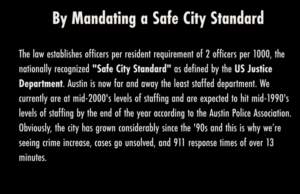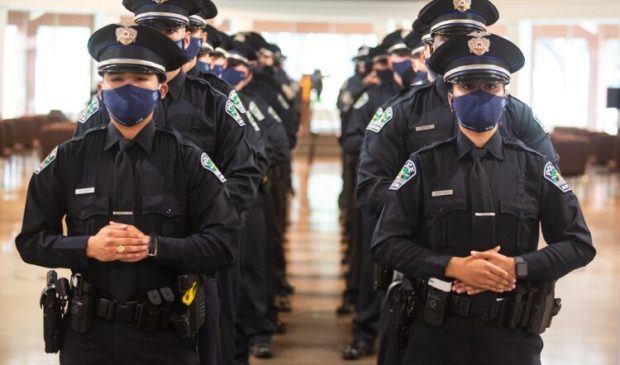Prop A would mandate 2 police officers per 1,000 residents. Where does that ratio come from?
Monday, October 25, 2021 by
Audrey McGlinchy, KUT What’s in a ratio? A lot, if voters are being asked to mandate one.
Proposition A, one of two local measures on the Nov. 2 ballot, asks Austinites if they want to set a minimum staffing ratio for the Austin Police Department: 2 police officers per 1,000 residents.
Save Austin Now, the group behind Prop A, has latched onto this ratio, calling it a “nationally recognized ‘safe city standard.'”
But it doesn’t appear to be.
A benchmark for police staffing
Save Austin Now’s website had attributed this definition to the U.S. Justice Department. But a search of the DOJ website turned up no such phrase. KUT reached out to the department to ask if it endorses a “safe city standard,” but did not hear back.

Save Austin Now could not show KUT where the definition originated. It later changed the attribution on its website to the National City Managers Association. But Matt Mackowiak, co-founder of Save Austin Now, did not provide KUT information to back this up, either.
The ratio appears to come from an average of officer staffing at police departments across the country. A 2015 report from the Bureau of Justice Statistics, for example, found that the average number of officers at municipal and township police departments was 2.1 per 1,000 residents. These were not necessarily departments in cities deemed “safe.”
Regardless, some police departments across the country began adopting this ratio as protocol.
“This ratio is a common general guideline that many cities strive for,” Bill Sousa, a criminal justice professor at the University of Nevada Las Vegas, told KUT.
While APD no longer uses this ratio as a benchmark for staffing, it did so for years, according to a spokesperson and several former mayors. City leaders acknowledged back then that using a ratio for staffing was not ideal.
“To tell you the truth, there is no absolute number,” Austin Deputy City Manager Michael McDonald told Council members at a budget discussion in 2013. “You really have to look at the resources that are needed.”
In the past decade, the city has paid for several studies to assess police staffing, at least one of which denounced the 2-per-1,000 ratio.
“Although the 2-per-1,000 ratio is convenient and provides dependable increases in police staffing as the city’s population rises, it does not appear to be based on an objective assessment of policing needs in Austin,” researchers with the Police Executive Research Forum wrote in a 2012 study. “Officers per 1,000 ratios are frequently used to compare departments to each other, but they have little value because they do not provide insight into how officers are used.”
Researchers instead assessed policing based on other factors, including employee workload. They recommended that APD hire 228 more patrol officers, which would have brought the department’s officer-to-resident ratio to 2.11 per 1,000.
Simple doesn't mean ideal
The 2-per-1,000 ratio is an average, and experts say it shouldn’t be considered anything more.
“As stupid ideas go, (using a ratio to staff police) ranks right up there with defunding the police,” John Eck, a professor of criminal justice at the University of Cincinnati, said.
Others agreed.
“It’s like if you went to the supermarket and weighed all of the people in the supermarket and said that the average weight was 180 pounds. It doesn’t mean that everybody should be 180 pounds,” Jim McCabe, an associate professor of criminal justice at Sacred Heart University in Fairfield, Conn., told KUT. “It’s just a description of the weight of the people that were in that store.”
In a study written for the International City/County Managers Association, McCabe, a former New York City police officer, wrote that departments use this ratio because it’s simple – but that doesn’t make it ideal.
“As easy as it is to comprehend and apply, this model is equally inefficient and unreliable,” he wrote.
When asked to provide proof of the 2-per-1,000 ratio being a “safe city standard,” Mackowiak sent KUT McCabe’s study. It does not include the phrase “safe city standard.”
McCabe acknowledged that two officers per 1,000 residents may work for Austin, but he said the department should get there by studying other metrics.“They may be right,” he said. “But just to say that’s because that’s the number around the country doesn’t mean that’s the right number for Austin.”
Factors to weigh in staffing
Police Chief Joseph Chacon won’t say where he stands on Prop A. But when questioned by Mayor Steve Adler at his confirmation hearing last month, Chacon said he doesn't believe in staffing a police department based on a ratio.
“The important thing is that we determine what services our community wants to see be delivered and then use the models that we develop to be able to determine exactly how many officers it’s going to take to obtain that,” he told Council members. “I think that’s just a smarter way to do business.”
Experts who study policing agree. They say city police departments should consider what officers’ duties are and what the demand for police is; one way of assessing this is calls for service, or 911 calls.
“We should really be studying, and what politicians and the public should be focusing on, is what police do, not how many cops they have,” Eck said. “Then you can ask the question: Well, how many people do we need to make this thing work? Then you have a relevant question in terms of staffing.”
Other relevant questions to ask, said Kim Rossmo, a professor of criminology at Texas State University, are: "What is the crime rate? What is the call load? What is the response time? What is the surrounding population? How many special events occur in a city population?"
APD recently made changes to how it handles 911 calls, including adding the option for a caller to ask for a mental health counselor instead of someone from the police, fire or EMS departments.
Chacon also recently announced police would not be handling non-emergency 911 calls anymore, saying this was both a product of staffing shortages and an attempt to move police off calls that could be handled by civilians.
“So we can keep our officers available on the streets for those in-progress calls for which we have found ourself short lately,” he told Council last month. “I do think that as we have gone through the reimagining effort (to reconsider the role of police) it meets those needs, as well.”
Data show that over the past five years, APD officers’ response to the most pressing emergency calls has slowed. In 2016, the average response time to a Priority 0 call, considered the most pressing, was close to six minutes; in 2021, the average has risen to nearly nine minutes.
In 2018, the number of officers employed by APD began falling; it has since dropped by 11 percent. The department often budgets for at least 100 more police officers than it's able to hire – which has gotten harder to do, according to Lt. Jay Swann, who recruits for the department.
Swann said one reason is the pay, which as the cost of living in Austin soars, some consider less competitive when compared to other departments. After graduating from the academy, police start making almost $63,000 a year; that jumps to more than $70,000 a year two years out from the academy.
“Pay is still very good,” Swann said. “But it's not something that we can use as an enticement.”
City Council voted in 2019 to pause new cadet classes until changes could be made to how police are trained. The Covid-19 pandemic delayed this work though, and nearly a year passed before the academy got a new curriculum and classes could resume.
A new cadet class started in June. While more than a dozen officers-in-training have left because of injury, Covid-19 or other reasons, according to a new report, 81 officers are on track to graduate.
If Prop A passes, it would require the city to hire hundreds of new officers. The city of Austin estimates between salaries, equipment and new substations to house more officers, Prop A could cost anywhere from $54 million to $120 million annually for the first five years. Save Austin Now's estimate includes only salaries and equipment and is therefore lower: $35 million a year.
Swann said some people are hesitant to join the force because of City Council’s call for changes to be made at APD. “They’re a little bit scared to join because the future (of law enforcement) is not certain,” he said.
This story was produced as part of the Austin Monitor’s reporting partnership with KUT.
The Austin Monitor’s work is made possible by donations from the community. Though our reporting covers donors from time to time, we are careful to keep business and editorial efforts separate while maintaining transparency. A complete list of donors is available here, and our code of ethics is explained here.
You're a community leader
And we’re honored you look to us for serious, in-depth news. You know a strong community needs local and dedicated watchdog reporting. We’re here for you and that won’t change. Now will you take the powerful next step and support our nonprofit news organization?









